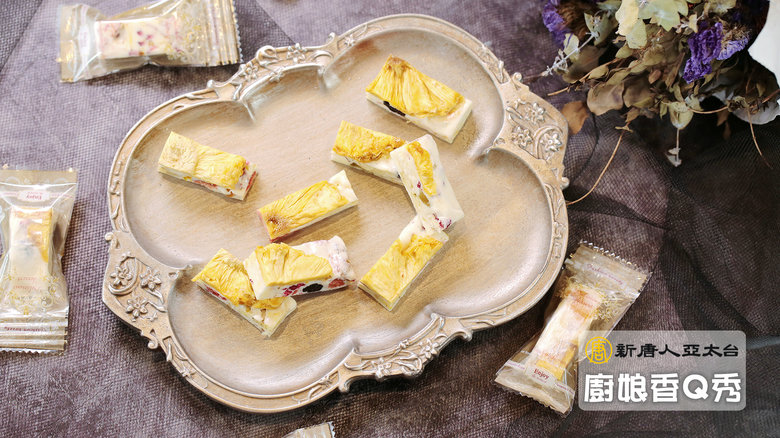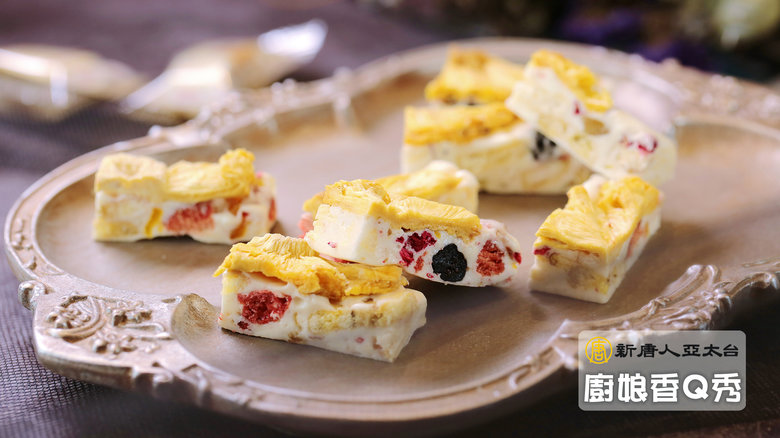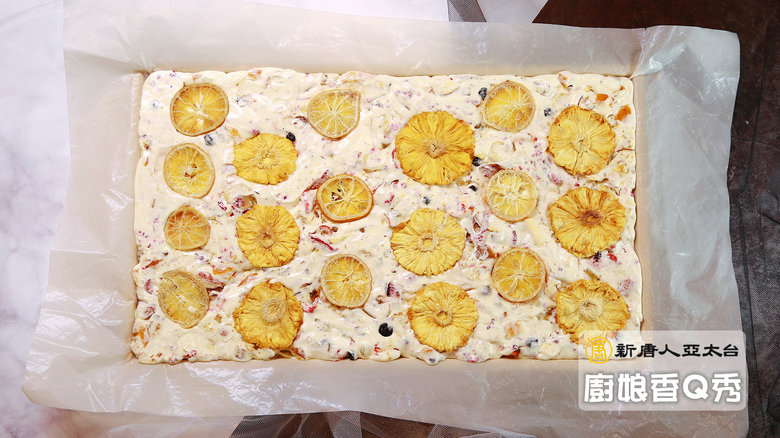https://www.youtube.com/watch?v=x5clLUpXPuk
水果重量接近900公克,口感在棉花糖及牛軋糖中間的什錦纖果Q軟牛軋糖,是本身教學及進修齊進的麥田金老師專為廚娘香Q秀節目製作的,擁有菓子教師證、塑型豆沙花教師證、巧克力花教師證等的麥田金老師提醒用蛋白霜粉(乾燥的蛋白)代替水份比較高的新鮮蛋白,是這樣比較好操作。蛋白霜粉一定要加冷開水攪勻,再用電動攪拌機快速打約三分鐘成表面紋路很細緻光澤度很好的乾性發泡,把盤子倒過來蛋白不會掉下來喔!
什錦纖果Q軟牛軋糖(蛋奶素)



材料:
A、水120克、寒天粉4克 (水30g、寒天粉1g)
B、細砂糖80克、鹽6克(砂糖20g、鹽1.5g)
C、86%水麥芽780克(水麥芽195g)
D、蛋白霜粉80克、冷開水80克(蛋白霜40g)
E、發酵奶油80克(奶油20g)
F、奶粉120克(奶粉30g)
G、綜合乾燥水果乾900克(藍莓50克、覆盆子50克、芒果100克、草莓100克、無花果100克、柚子皮100克、香蕉90克、蘋果100克、鳯梨及柳橙適量)(果乾225g)
做法:
1.蛋白霜粉加冷開水攪勻,用電動攪拌機快速打約三分鐘成乾性發泡,備用。
2.寒天粉泡水30分鐘,選一個有深度的鍋子,中小火加熱寒天粉,煮滾後再沸騰約三十秒左右熄火。加入白砂糖或海藻糖後再加一點點鹽,開火煮開後,熄火。
3.另一鍋子的水麥芽加熱回軟,熄火。水麥芽加入寒天粉泡水中,煮到鍋中糖漿重量780公克 (195g)(可以正負五公克)熄火。
4.備用的蛋白霜粉再用電動攪拌機快速打約30秒補充空氣進去。蛋白霜粉分二次加入已熄火且已加入水麥芽的寒天粉泡水中,輕輕攪勻。(如拿起來沒有流動感或攪拌不易,表示溫度低了,可開小小火20秒,即要關掉火,以免蒸掉糖裡水分。)
5.加入發酵奶油攪拌均勻。可開小小火20秒,即要關掉火。
6.全脂即溶奶粉加入,拌勻。
7.加入乾燥水果:先加軟Q的芒果、無花果等水果,再加乾脆的蘋果、香蕉、草莓等拌勻,總重300公克,拌入糖漿中,拌勻,一小團一小團的倒在舖了烤焙布的糖盤上,推平,在糖果表面貼上柳橙片及鳳梨片乾。用透氣的烤焙布鋪在上面, 放涼後即可以切,或者也可用保鮮膜放24小時再切,放的時間長比較好切開。
8.糖果冷却後,上面放一張烘焙紙,把整個糖果翻過來,撕開烘焙布後再放上一張烘焙紙,再翻回正面撕開烘焙紙。切小塊,長3.5-4公分寛度1.5公分,儘快包裝。
來賓簡介
麥田金老師。著作:1.麥田金老師的解密烘焙:糖果 2.麥田金老師的解密烘焙:蛋糕與裝飾3. 麥田金老師的解密烘焙:超萌甜點零失敗!88款療癒系裝飾午茶餅乾、蛋糕與西點4.甜派、鹹派、慕斯、水果塔 5. 烘焙食品乙級完勝密技全攻略 烘焙食品丙級完勝密技




















